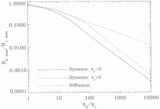Solar Interface Dynamos. I. Linear, Kinematic Models in Cartesian Geometry
Abstract
We describe a simple, kinematic model for a dynamo operating in the vicinity of the interface between the convective and radiative portions of the solar interior. The model dynamo resides within a Cartesian domain, partioned into an upper, convective half and lower, radiative half, with the magnetic diffusivity η of the former region (η2) assumed to exceed that of the latter (η1). The fluid motions that constitute the α-effect are confined to a thin, horizontal layer located entirely within the convective half of the domain; the vertical shear is nonzero only within a second, nonoverlapping layer contained inside the radiative half of the domain. We derive and solve a dispersion relation that describes horizontally propagating dynamo waves. For sufficiently large values of a parameter analogous to the dynamo number of conventional models, growing modes can be found for any ratio of the upper and lower magnetic diffusivities. However, unlike kinematic models in which the shear and α-effect are uniformly distributed throughout the same volume, the present model has wavelike solutions that grow in time only for a finite range of horizontal wavenumbers.
An additional consequence of the assumed dynamo spatial structure is that the strength of the azimuthal magnetic field at the location of the α-effect layer is reduced relative to the azimuthal field strength at the shear layer. When the jump in η occurs close to the α-effect layer, it is found that over one period of the dynamo's operation, the ratio of the maximum strengths of the azimuthal fields at these two positions can vary as the ratio (η1/η2) of the magnetic diffusivities.- Publication:
-
The Astrophysical Journal
- Pub Date:
- September 1997
- DOI:
- 10.1086/304484
- Bibcode:
- 1997ApJ...486..484M
- Keywords:
-
- Magnetohydrodynamics: MHD;
- Methods: Analytical;
- Sun: Interior;
- Sun: Magnetic Fields
